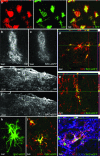Transplantation of glial progenitors that overexpress glutamate transporter GLT1 preserves diaphragm function following cervical SCI
- PMID: 25492561
- PMCID: PMC4351463
- DOI: 10.1038/mt.2014.236
Transplantation of glial progenitors that overexpress glutamate transporter GLT1 preserves diaphragm function following cervical SCI
Abstract
Approximately half of traumatic spinal cord injury (SCI) cases affect cervical regions, resulting in chronic respiratory compromise. The majority of these injuries affect midcervical levels, the location of phrenic motor neurons (PMNs) that innervate the diaphragm. A valuable opportunity exists following SCI for preventing PMN loss that occurs during secondary degeneration. One of the primary causes of secondary injury is excitotoxicity due to dysregulation of extracellular glutamate homeostasis. Astrocytes express glutamate transporter 1 (GLT1), which is responsible for the majority of CNS glutamate clearance. Given our observations of GLT1 dysfunction post-SCI, we evaluated intraspinal transplantation of Glial-Restricted Precursors (GRPs)--a class of lineage-restricted astrocyte progenitors--into ventral horn following cervical hemicontusion as a novel strategy for reconstituting GLT1 function, preventing excitotoxicity and protecting PMNs in the acutely injured spinal cord. We find that unmodified transplants express low levels of GLT1 in the injured spinal cord. To enhance their therapeutic properties, we engineered GRPs with AAV8 to overexpress GLT1 only in astrocytes using the GFA2 promoter, resulting in significantly increased GLT1 protein expression and functional glutamate uptake following astrocyte differentiation in vitro and after transplantation into C4 hemicontusion. Compared to medium-only control and unmodified GRPs, GLT1-overexpressing transplants reduced lesion size, diaphragm denervation and diaphragm dysfunction. Our findings demonstrate transplantation-based replacement of astrocyte GLT1 is a promising approach for SCI.
Figures








Similar articles
-
Overexpression of the astrocyte glutamate transporter GLT1 exacerbates phrenic motor neuron degeneration, diaphragm compromise, and forelimb motor dysfunction following cervical contusion spinal cord injury.J Neurosci. 2014 May 28;34(22):7622-38. doi: 10.1523/JNEUROSCI.4690-13.2014. J Neurosci. 2014. PMID: 24872566 Free PMC article.
-
Human iPS cell-derived astrocyte transplants preserve respiratory function after spinal cord injury.Exp Neurol. 2015 Sep;271:479-92. doi: 10.1016/j.expneurol.2015.07.020. Epub 2015 Jul 26. Exp Neurol. 2015. PMID: 26216662 Free PMC article.
-
GLT1 overexpression in SOD1(G93A) mouse cervical spinal cord does not preserve diaphragm function or extend disease.Neurobiol Dis. 2015 Jun;78:12-23. doi: 10.1016/j.nbd.2015.03.010. Epub 2015 Mar 25. Neurobiol Dis. 2015. PMID: 25818008
-
Descending bulbospinal pathways and recovery of respiratory motor function following spinal cord injury.Respir Physiol Neurobiol. 2009 Nov 30;169(2):115-22. doi: 10.1016/j.resp.2009.08.004. Epub 2009 Aug 12. Respir Physiol Neurobiol. 2009. PMID: 19682608 Review.
-
Aquaporins in spinal cord injury: the janus face of aquaporin 4.Neuroscience. 2010 Jul 28;168(4):1019-35. doi: 10.1016/j.neuroscience.2010.01.037. Epub 2010 Jan 28. Neuroscience. 2010. PMID: 20109536 Free PMC article. Review.
Cited by
-
AAV2-BDNF promotes respiratory axon plasticity and recovery of diaphragm function following spinal cord injury.FASEB J. 2019 Dec;33(12):13775-13793. doi: 10.1096/fj.201901730R. Epub 2019 Oct 2. FASEB J. 2019. PMID: 31577916 Free PMC article.
-
Differential Response in Novel Stem Cell Niches of the Brain after Cervical Spinal Cord Injury and Traumatic Brain Injury.J Neurotrauma. 2018 Sep 15;35(18):2195-2207. doi: 10.1089/neu.2017.5497. Epub 2018 Jun 7. J Neurotrauma. 2018. PMID: 29471717 Free PMC article.
-
Stem and Progenitor Cell-Derived Astroglia Therapies for Neurological Diseases.Trends Mol Med. 2015 Nov;21(11):715-729. doi: 10.1016/j.molmed.2015.09.003. Epub 2015 Oct 3. Trends Mol Med. 2015. PMID: 26443123 Free PMC article. Review.
-
Reactive Astrocytes in Central Nervous System Injury: Subgroup and Potential Therapy.Front Cell Neurosci. 2021 Dec 23;15:792764. doi: 10.3389/fncel.2021.792764. eCollection 2021. Front Cell Neurosci. 2021. PMID: 35002629 Free PMC article. Review.
-
Mid-cervical spinal cord contusion causes robust deficits in respiratory parameters and pattern variability.Exp Neurol. 2018 Aug;306:122-131. doi: 10.1016/j.expneurol.2018.04.005. Epub 2018 Apr 10. Exp Neurol. 2018. PMID: 29653187 Free PMC article.
References
-
- Strakowski JA, Pease WS, Johnson EW. Phrenic nerve stimulation in the evaluation of ventilator-dependent individuals with C4- and C5-level spinal cord injury. Am J Phys Med Rehabil. 2007;86:153–157. - PubMed
Publication types
MeSH terms
Substances
Grants and funding
LinkOut - more resources
Full Text Sources
Other Literature Sources
Medical
Miscellaneous

